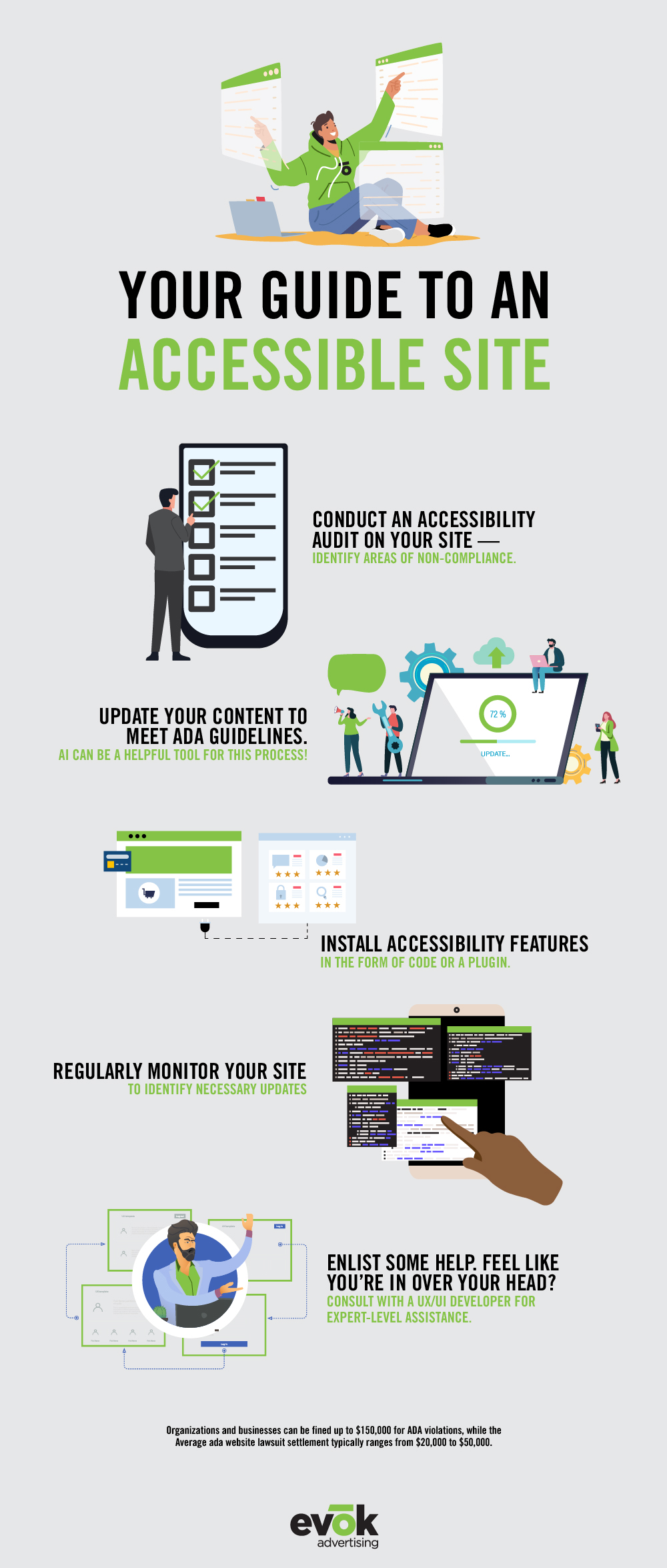
The Transformative Influence of AI on Web Accessibility
In recent years, artificial intelligence (AI) has emerged as a groundbreaking technology that is revolutionizing various industries. One area, we want to focus on, where AI is making a significant impact is web accessibility. Web accessibility refers to designing websites and applications that can be used by all individuals, regardless of their abilities or disabilities. With AI’s capability to analyze and understand complex data, it is reshaping the landscape of web accessibility, making the online world a more inclusive and empowering place for everyone.

Why Digital Accessibility is Important
June 17th, 1995, web accessibility has been a part of web development and began with more than 38 guidelines to serve as the starting point for Web Content Accessibility Guidelines (WCAG). AS recently as 2010, the passing of the Americans with Disabilities Act Standards for Accessible Design by the U.S. Department of Justice. This legislation mandated all electronic and information technology, including websites, be equally accessible to those with disabilities as to those without disabilities.
Inaccessible web content means visitors with disabilities are denied equal access to the information on a website. These barriers can exclude people with disabilities similarly to how steps to a physical location entrance could.

Web accessibility encompasses the design and development of websites and applications that can be used by individuals with disabilities. Failure to comply with ADA and WCAG accessibility regulations can have significant consequences, ranging from legal issues and financial penalties to reputational damage and missed business opportunities. Embracing web accessibility as a fundamental aspect of web design and development is essential for creating an inclusive online environment and avoiding potential legal pitfalls.
Enhancing Screen Reader Capabilities

AI-powered technologies are enhancing the capabilities of screen readers, which are vital tools for individuals with visual impairments. Through advanced image recognition and natural language processing algorithms, AI can accurately describe images, graphics, and other visual elements on web pages, providing a more comprehensive and immersive browsing experience for visually impaired users.
In previous adaptations to screen reader capabilities, images were described manually by using “alt text” or “alt tags.” Alt text is a descriptive text attribute that can be applied to an HTML image tag with the purpose of providing a textual description of the image’s content for those with visual impairments who use screen readers. Additionally, alt text could only provide a limited level of information about images. It was challenging to convey complex visual elements, such as graphs, charts, or detailed illustrations, solely through text. Users relying on screen readers would miss out on crucial visual information that was not adequately described in the alt text. AI can be used to “bridge the gap” between human input and digital accessibility.
Automated Captioning and Transcription

Another significant impact of AI in web accessibility is the automation of captioning and transcription services. AI algorithms can analyze audio and video content in real-time and generate accurate captions, making online videos accessible to individuals with hearing impairments. This technology also benefits non-native speakers and those who prefer reading over listening, fostering greater inclusion and engagement not only for those with physical disabilities, but language barriers as well.
Personalized Assistive Technologies
AI algorithms have the potential to create personalized assistive technologies for individuals with diverse disabilities. By leveraging machine learning techniques, AI can adapt to users’ preferences, learning their behavior patterns and customizing the browsing experience accordingly. One example of personalized assistive technology is cognitive support tools, with AI, these tools can organize and simplify information, assist with memory and task management, and can even set reminders. This level of personalization empowers users with disabilities to navigate the web more efficiently, improving their overall online experience.
Natural Language Processing for Voice Interfaces
Voice interfaces, such as voice assistants and chatbots, have become increasingly popular. AI’s natural language processing capabilities play a crucial role in enhancing the accessibility of these interfaces. By understanding and interpreting user queries more accurately, AI-powered voice interfaces can provide more precise responses and better cater to the needs of individuals with speech impairments or physical disabilities. With the emergence of AI and AI tools becoming more widely available and used, we can expect AI-powered algorithms to become more detailed and minimize human input errors.
Automated Accessibility Testing
Ensuring web accessibility can be a time-consuming and complex process. However, AI-powered tools can automate the accessibility testing of websites and applications. These tools can scan web content, detect accessibility issues, and provide developers with detailed reports and recommendations for improvement. By automating these processes, AI accelerates the identification and resolution of accessibility barriers, promoting inclusivity from the initial stages of website development.
Conclusion
AI is reshaping the landscape of web accessibility, bringing us closer to a more inclusive online world. From improved screen reader capabilities and automated captioning to personalized assistive technologies and automated accessibility testing, AI is making digital content accessible to individuals with disabilities.
If your organization’s website is non-compliant with WCAG/ADA, it is important to recognize this matter before it could become a larger legal issue. Reach out to our team at evok Advertising to learn more about:
- Conducting an Accessibility Audit on your site: Start by conducting a thorough accessibility audit of your website to identify areas of non-compliance.
- Updating your web content to meet accessibility guidelines: Review and update website content to meet accessibility guidelines and standards.
- Install accessibility features in the form of code or a plugin.
- regularly monitor your site for updated content, and updated compliance: conduct regular accessibility checks, both manually and using automated tools, to catch any new accessibility issues that may arise due to content updates or website changes
As AI continues to advance, it holds the potential to further bridge the accessibility gap, enabling equal access to information and opportunities for everyone. It is essential for developers and designers to embrace AI technologies and prioritize web accessibility to ensure a truly inclusive digital environment for all. It is equally essential to consider that web accessibility does not happen overnight and to focus on the more critical accessibility barriers and gradually work towards improving the overall accessibility of your website to make it a more inclusive place for all.
Ready to dig deeper? Give us a call. Book time with our team to discuss how adopting AI marketing strategies can help your business grow.